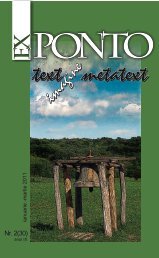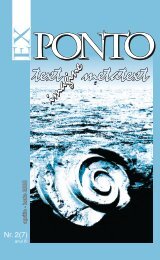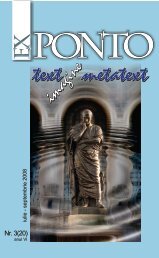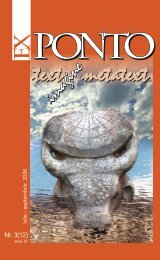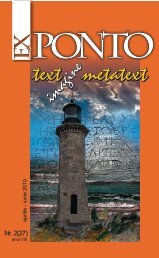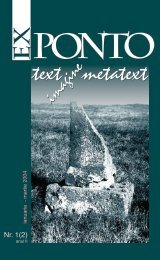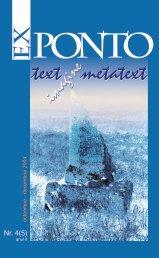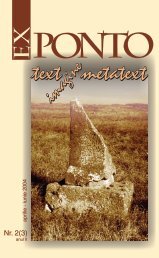Nr. 3 (32) anul IX / iulie-septembrie 2011 - ROMDIDAC
Nr. 3 (32) anul IX / iulie-septembrie 2011 - ROMDIDAC
Nr. 3 (32) anul IX / iulie-septembrie 2011 - ROMDIDAC
Create successful ePaper yourself
Turn your PDF publications into a flip-book with our unique Google optimized e-Paper software.
the Mundy sisters. This is one of the most exquisite instances of non-verbal<br />
communication featured in the play.<br />
When I remember it, I think of it as dancing. Dancing with eyes half<br />
closed because to open them would break the spell. Dancing as if language<br />
had surrendered to movement – as if this ritual, this wordless ceremony,<br />
was now the way to speak, to whisper private and sacred things, to be<br />
touched with some otherness. Dancing as if the very heart of life and all its<br />
hopes might be found in those assuaging notes and those hushed rhythms<br />
and in those silent and hypnotic movements. Dancing as if language no<br />
longer existed because words were no longer necessary ... (Friel 71)<br />
The dance portrays a moment when unity accompanied by “individuality<br />
and sexual frustration finds an almost frightening release” (Lojek 82). The<br />
shortness of the explosive moment in set in contrast with the ongoing routine<br />
of the sisters’ lives. The song is “The Mason’s Apron”, an instrumental Irish reel<br />
played by a céilí band. Wiring on it, Friel emphasized this aspect of music:<br />
And a similar piece – only more anguished and manic – in Dancing<br />
at Lughnasa. And in both plays the purpose was to explode theatrically<br />
the stifling rituals and discretions of family life. And since words didn’t<br />
seem to be up to the job it was necessary to supply the characters with<br />
a new language. Because at that specific point in both plays when the<br />
céilí music is used, words offer neither an adequate means of expression<br />
nor a valve for emotional release. Because at that specific point emotion<br />
has staggered into inarticulacy beyond the boundaries of language. And<br />
that is what music can provide in the theatre: another way of talking, a<br />
language without words. And because it is wordless it can hit straight and<br />
unmediated into the vein of deep emotion. (Friel in Lojek 83)<br />
There is a certain sense of the grotesque in the description of the<br />
sisters’ dance. It may resemble a Dionysian fertility rite. In contrast with Father<br />
Jack’s memories of the African festive dancing, which seem to have a certain<br />
warmth, the sisters’ performance lapses into a caricature. In Africa:<br />
We light fires round the periphery of the circle; and we paint our faces<br />
with coloured powders; and we sing local songs; and we drink palm wine.<br />
And then we dance – and dance – and dance, children, men, women,<br />
most of them lepers, many of them with misshapen limbs, with missing<br />
limbs – dancing, believe it or not, for days on end! It is the most wonderful<br />
sight you have ever seen! (Friel 48)<br />
Interestingly, when the boy’s kites can be seen in the last scene of the<br />
play “on each kite is painted a crude, cruel, grinning face, primitively drawn,<br />
garishly painted” (Friel 70). The sisters’ dance gains its rhythm gradually:<br />
The music, at first scarcely audible, is Irish dance music – ‘The Mason’s<br />
Apron’, played by a ceili band. Very fast; very heavy beat; a racous music.<br />
[...] Agnes and Rose, Chris and Maggie, are now all doing a dance that<br />
is almost recognizable. They meet – they retreat. They form a circle and<br />
wheel round and round. [...] Kate dances alone, totally concentrated, totally<br />
Ex Ponto nr. 3, <strong>2011</strong><br />
177




